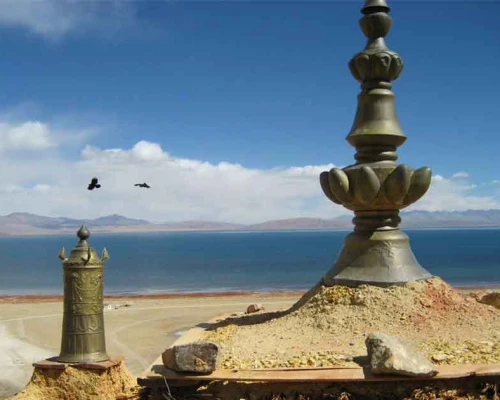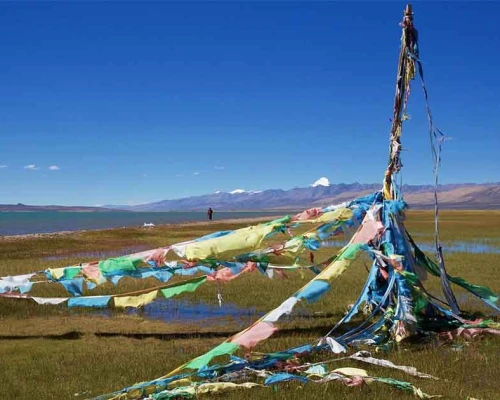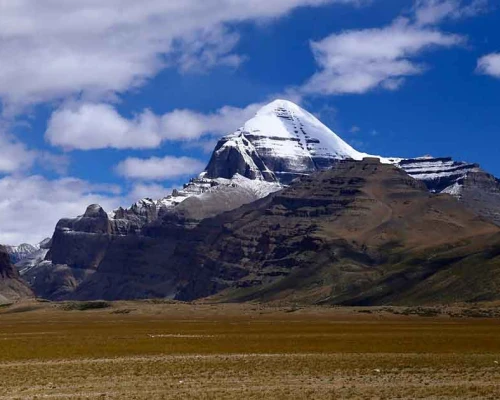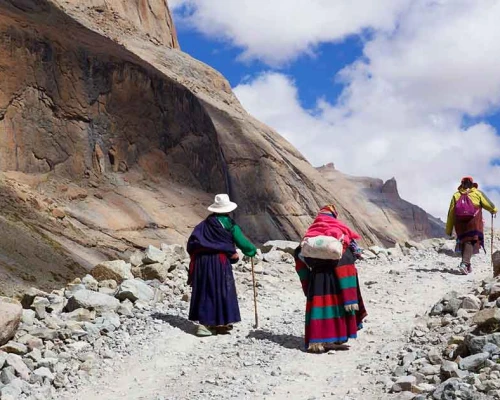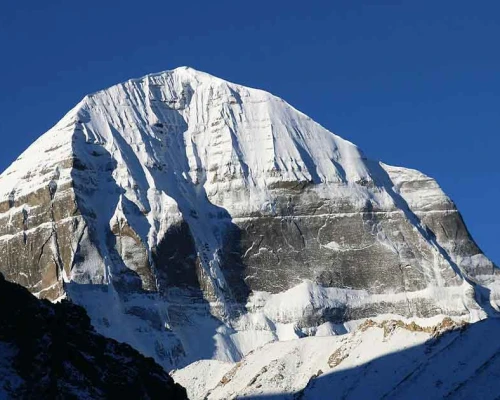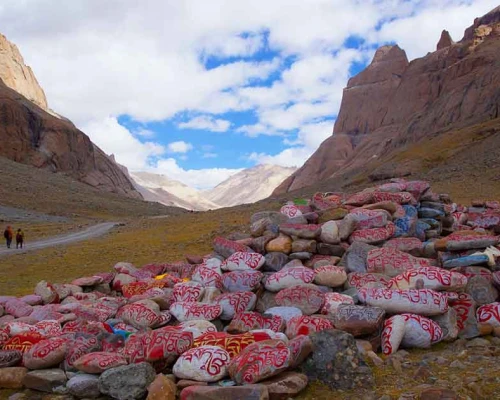Kailash Mansarovar Yatra A Sacred Pilgrimage to the Abode of Lord Shiva
The Kailash Mansarovar Yatra is one of the most revered spiritual journeys in the world. At the heart of this pilgrimage lies Mount Kailash, a peak believed to be the celestial abode of Lord Shiva, his consort Parvati, and their children Ganesha and Kartikeya. This sacred mountain symbolizes a divine connection, as its summit is thought to be the closest point to heaven or other spiritual realms in Hindu belief.
Located in the Kailash Range (Gangdisê Mountains) of the Transhimalaya in western Tibet, Mount Kailash is not only a spiritual icon but also a geographic marvel. It is the source of several major rivers, including the Yarlung Tsangpo (which becomes the Brahmaputra), the Indus, the Sutlej, and the Karnali, a tributary of the Ganges. Remarkably, all these river systems originate from a compact 60 km² (23 sq mi) area around the mountain.
Nearby, the sacred Lake Mansarovar, a high-altitude freshwater lake fed by glacial waters sits beside Rakshastal, a saltwater lake. Mansarovar is deeply significant in Hinduism, Buddhism, Jainism, and Bon traditions. It is believed that taking a holy dip in this lake purifies the soul and washes away sins.
Each year, thousands of pilgrims from India, Nepal, and beyond undertake the Kailash Mansarovar Yatra, a spiritual expedition involving a journey to Lake Mansarovar followed by a circumambulation (parikrama) of Mount Kailash. The 53 km (33 mi) kora (circumambulation) is completed on foot and holds immense spiritual significance.
According to Hindu belief, completing this journey brings spiritual merit (punya), purifies past karma, and bestows blessings and good fortune. Hindus traditionally walk the path clockwise, in reverence and devotion.
The entire Kailash Mansarovar tour typically starts and ends in Kathmandu, Nepal, and is completed over 15 days. This pilgrimage is not just a physical journey but a profound inner quest for spiritual transformation and divine connection.
Mount Kailash Mansarovar Tour from Kathmandu for 2026 and 2027 with Date & Cost
The Kailash Mansarovar Yatra Tour Package is a pre planned itinerary for a memorable pilgrimage with a beautiful travel journey to the holiest Mount Kailash and a sacred water body, Mansarovar Lake. These places hold respect and devotion in the faiths of millions around the world, such as Hinduism, Buddhism, Jainism, and Bon.
This spiritual tour to Mount Kailash begins in Kathmandu, the capital city of Nepal. People believe that the sacred aura of Mount Kailash and the beautiful, holy Lake Mansarovar purify the mind and wash away sins. Usually, pilgrims go through Kerung or Hilsa to get to the border between Nepal and Tibet. From there, they can witness snow-covered peaks and the endless Tibetan plains. When you go to Mansarovar by land from Kathmandu, you can get spiritual energy along with some comfort and excitement.
Likewise, this Hindu pilgrimage to Kailash Mansarovar also know as the religious Mount Kailash parikrama, 53 km (33 mi) kora also symbolizes a spiritual cycle of rebirth and enlightenment. Along the way, pilgrims pay visits to other important sacred spots such as Yam Dwar, Gauri Kund, and Dolma La Pass at a high altitude.
Additionally, this yatra to Mount Kailash has become a severe test of physical endurance while unfolding as a transformational journey of belief, devotion, and self-realization. Assisted by famed agencies in Nepal, the Kailash Mansarovar trips from Kathmandu are more accessible than ever, with options being offered for departure in a group or as a private package tailored to one's needs.
Pre-Booking Note
Advance bookings for the Kailash Mansarovar Yatra are open for international travelers from April to September in 2026 and 2027. Reserve your spot for the spiritual journey by choosing from our fixed departure dates specially designed for foreign nationals. Regarding the Indian travelers, we will soon update the opening dates for Kailash Yatra.
Fixed Departure Dates of Kailash Mansarovar Pilgrimage for 2026
Here are the fixed departure dates for the 2026 Mount Kailash Mansarovar Tour for foreigners. Our set Kailash and Mansarovar Yatra departure dates are guaranteed during full moon times. However, should any rule be changed by the Government of China, things might change under unexpected circumstances. For Indian tourists, please WhatsApp us or email us with a query.
Departure Dates of Kailash Mansarovar Yatra 2026 | Dates for Charan Sparsh and Full Moon Schedule
Tour Start Date | Tour End Dates | Trip Type |
2nd July 2026 | 18th July 2026 | Full Moon Yatra + Charan Sparsh |
3rd August 2026 | 16th August 2026 | Full Moon Yatra + Charan Sparsh |
31st August 2026 | September 14, 2026 | Full Moon Yatra + Charan Sparsh |
10th September 2026 | 26th September 2026 | Regular Tour |
Kailash Mansarovar Yatra Tour Cost
Kailash Mansarovar Yatra varies according to group and personal choices. The tour is for 11 days from Kathmandu to Kathmandu, but considering the arrangement of the Tibet Travel Permit and Tibet Visa within, the entire trip can be extended to about 15 to 16 days. This pilgrimage is one of our more premium tours due to the permits and logistics involved in Tibet.
The cost of the Kailash Mansarovar Tour is USD 2750 per person on a group joining basis for groups of 25 or more. If there is a completely private group of 10 to 15 travelers, the cost is USD 3500 per person.
If you have a smaller group, like family or a couple of friends, then you can pick any date to travel from our fixed departure calendar. If you are organizing a private group of up to 15 people, your group can select a travel date that works best for the counterparty.
The package price includes the Tibet Travel Permit. We get the paperwork for your permits and passes. On arrival in Nepal, all we need is your original passport to apply for your Tibet Visa. We'll handle the rest so you can have a smooth, stress-free trip.
Additional Costs to Consider for the Kailash Mansarovar Yatra
Most of the expenses are taken care of, though there are some costs that need to have provisions made for them. You can read our package details for specific information about what is included and what is not included. Some extra expenses that you might need to incur during the course of the journey include
Meals in Kathmandu: As part of your package, breakfast and dinner are both taken at the hotel in Kathmandu. Still, lunch will be a personal expense. Eating at a decent restaurant would normally run you about USD 15-20 per meal and will be augmented by any beverage or even alcoholic drink.
Hiring a Local Porter for Parikrama: If you require some help during the Kailash Parikrama (Kora), one can take a local porter who will carry a small daypack (not more than 5 kg) for a cost of Chinese yuan 1,300 to 1,500.
Hire a Horse for Parikrama: Horses may be rented for pilgrims who find trekking too strenuous. Rental for a horse, saddle, and guide for one person to handle the horse and carry a small bag (up to 5 kg) would cost around 4,500 to 5,000 yuan per person for the entire Parikrama.
Hotel Upgrade in Darchen: Standard packages usually have 2 or 3-star-rated hotels in Darchen. For a 4-star hotel, it will cost an additional $60 extra per person.
Alternative Arrangement in Case of Incomplete Parikrama: If you are unable to complete the full Parikrama for any reason, such as health reasons, tiredness, or just your wish, and need to return to Darchen instead of across the Dolma-La from Derapuk, the extra night at a hotel will be at your expense in Darchen. The cost would be in the range of CNY 400 to 500 per room, depending on the price of the establishment. The charge will not be refundable for a place you booked at Zuthulpuk beforehand during your trek. If you choose to stay in Darchen instead of starting the Parikrama, your package includes this cost.
Outlined Itinerary of Kailash Mansarovar Yatra from Kathmandu
Days | Activities | Altitude | Accommodation | Meals |
1 | Arrival in Kathmandu | 1,320m / 4,330ft | Standard hotel | DInner |
2 | Free Day for Visa Processing | 1,320m / 4,330ft | Standard hotel | Breakfast & Dinner |
3 | Chinese Visa Processing / Free Day | 1,320m / 4,330ft | Standard hotel | Breakfast & Dinner |
4 | Kathmandu CIty Tour | 1,320m / 4,330ft | Standard hotel | Breakfast & Dinner |
5 | Drive from Kathmandu to Timure | ~1,550m | Basic lodge/teahouse | Breakfast, Lunch & Dinner |
6 | Drive to Kerung (Tibet Border) | ~2,800m | Basic lodge | Breakfast, Lunch & Dinner |
7 | Acclimatization Day at Kerung | ~2,800m | Basic lodge | Breakfast, Lunch & Dinner |
8 | Drive to Saga | 4,450m | Tourist lodge | Breakfast, Lunch & Dinner |
9 | Drive to Lake Manasarovar | 4,558m | Basic teahouse | Breakfast, Lunch & Dinner |
10 | Puja & Drive to Darchen | 4,575m | Basic teahouse | Breakfast, Lunch & Dinner |
11 | Trek to Derapuk (1st Day of Kora) | 5,000m | Basic teahouse | Breakfast, Lunch & Dinner |
12 | Trek to Zuthulpuk via Dolma-La Pass | 5,630m | Basic teahouse | Breakfast, Lunch & Dinner |
13 | Trek End & Drive Back to Saga | 4,450m | Tourist Lodge | Breakfast, Lunch & Dinner |
14 | Drive to Kerung | ~2,800m | Basic lodge | Breakfast, Lunch & Dinner |
15 | Drive to Kathmandu | 1,320m | Standard hotel | Breakfast, Lunch & Dinner |
16 | Final Departure from Kathmandu | - | - | Breakfast |
Kailash Mansarovar Yatra in Horse Year: A Spiritually Powerful Journey in 2026
The year 2026 proceeds in the Horse Year and hence proves an eminent day to commemorate with the Lord Shiva and Tibetan Buddhist followers. As per the belief in antiquity, provisioning to Holy Kora (circumambulation) of Mount Kailash in the Horse Year entails 108 times the merit than it would for any other year.
Hence, this rare combination makes the ongoing year the most auspicious period to perform this sublime journey. Both Mount Kailash and Lake Mansarovar are considered the most potent centers of divine energy, thus attracting pilgrims from across the world to have episodes of spiritual purification, blessings, and transformation.
Once in every 12 years comes the Horse Year in the Tibetan lunar calendar, with 2026 expected to see high occurrences of international pilgrims. Due to this rare opportunity, travelers are advised to book their allotments beforehand. Fixed dates for departure are arranged for foreign passport holders only.
The yatra is considered incomplete without the ritual of taking a holy dip in Lake Mansarovar followed by Kailash Parikrama, both of which become even more spiritually rewarding during this period. The Kailash Mansarovar Yatra in 2026 is thus the best occasion for anyone seeking profound spiritual fulfillment, tranquility, and divine communion—who has it but once in a Lifetime.
Fixed Departure Dates for Kailash Mansarovar Yatra 2026 (Horse Year)
These fixed departure dates are specially curated for Western Passport Holders (Non-Indian Citizens). Experience the spiritual Kailash Mansarovar Yatra in the sacred Horse Year 2026. Our fixed departure packages are designed specifically for foreign nationals and include the complete pilgrimage experience.
- Mount Kailash Kora (Sacred circumambulation of the holy mountain)
- Mansarovar Lake Kora (Pilgrimage around the divine lake)
Kathmandu Arrival | Visa Apply | Final Departure | Remarks |
03rd May 2026 | 04th May 2026 | 17th May 2026 | Full Moon |
17th May 2026 | 18th May 2026 | 01st June 2026 | |
31st May 2026 | 01st June 2026 | 15th June 2026 | Full Moon |
29th June 2026 | 30th June 2026 | 14th July 2026 | Full Moon |
28th July 2026 | 29th July 2026 | 11th August 2026 | Full Moon |
26th August 2026 | 27th August 2026 | 10th September 2026 | Full Moon |
13th September 2026 | 14th September 2026 | 28th September 2026 | |
20th September 2026 | 21st September 2026 | 05th October 2026 | Full Moon |
Note: These departure dates are open for Western passport holders only. Each departure includes complete permit assistance, visa processing, and guided support throughout the journey. Due to limited permits and high demand in the Horse Year, we highly recommend booking early.
Custom Group Option
- Are you traveling with a private group of up to 15 people? You can choose your travel date through the private booking section.
- Are you traveling in a small group or as a couple? You’re welcome to join any of our fixed departure dates.
Kailash Mansarovar Yatra for Indian Passport Holders—Now Officially Open
After a long five-year break, we are pleased to declare the Kailash Mansarovar Yatra officially reopened for Indian nationals! The Tibetan government in Lhasa has recently confirmed that Indian passport holders can now embark on the pilgrimage starting from July 2026. For Indian pilgrims, the announcement is a much-awaited chance to once more start the spiritually transforming trip to Mount Kailash and Lake Mansarovar.
We are now accepting bookings for group departures for the 2026 Kailash Mansarovar Yatra. This 13 Nights / 14 Days twin-sharing package is specially designed to offer a smooth, safe, and spiritually fulfilling journey. The package includes comfortable lodging, pure vegetarian meals, all necessary permits, guided support throughout the yatra, and complete ground transportation. For pricing details applicable to Indian travellers or Indian passport holders, please contact us directly. Early booking is recommended as seats are limited.
Important Travel Tips for Indian Passport Holders
Please guarantee your passport so that the visa application goes hassle-free.
- Ensure your passport remains valid for at least six months beyond the date you intend to travel.
- Your passport should have a minimum of two blank Visa pages.
- Because you want to go in September 2026, near the end of the season, your passport should really be good until March or April 2027.
Booking process of Kailash Mansarovar Yatra
You can book the Kailash Mansarovar Yatra through our online booking system with ease. We cater to both group and private tours, accommodating a single individual or a group of up to 25 passengers on your preferred dates. Follow the steps below to secure your spot:
Booking a Group Tour
- Step 1: Click the "Check Departures" button to view all available dates and prices for the Kailash Mansarovar Yatra.
- Step 2: Select your desired trip month and date, then click "Book Now."
- Step 3: Enter the number of travelers, complete the booking form, and click the "Proceed to Payment" button.
- Step 4: After completing your payment, you will receive an email confirmation from Nepal Trek Adventures. This email will confirm your booking and provide further details about the trip. Our team will coordinate with you based on the information provided during the booking process.
Booking a Private Tour
- Step 1: Click the "Personalized Trip" button to explore available dates and prices for private tours.
- Step 2: Choose your preferred travel date and proceed with booking.
- Steps 3 & 4: Follow the same steps as for the group tour, including payment and confirmation.
Payment Methods
You can pay using a variety of credit cards, including Visa, MasterCard, American Express, and Union Pay. Our online payment system is equipped with 3D Secure Payment Processing technology, such as MasterCard SecureCodeTM and Verified by Visa Compliance, ensuring your card details are safe and secure throughout the transaction process.
Booking Confirmation Note
To confirm your Kailash Mansarovar package, a non-refundable booking amount of USD 500 should be paid along with a copy of the passport. The rest of the amount will be required to be paid at the arrival point in Kathmandu before the commencement of your trip. Payments can be made easily and safely online through the "Book Now" option using one's credit card. Please note that the payment for the USD 500 booking fee is non-refundable and non-transferable.
Book now and get free t-shirts, caps, and stickers.



